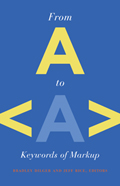Given the focus of the book, it is fitting that the first chapter is dedicated to the <head>, the section of an HTML file that exists outside the bounds of the visible body content. Thomas Rickert examines the role of the <head> in relation with that of the <body> (for an analysis of the latter, see Bay), comparing the setup in HTML to the head/body binary proposed by Descartes and indicative of a perspective not fully reflective of the potential for distributed community possible through hypertext communication.
Rickert observes that recommendation-based protocol has the potential to replace rule-based control (and in fact is already a fundamental component of Internet communication); rather than building a rigidly hierarchical system in which top-down control is easy to maintain, Berners-Lee and the other developers of hypertext transfer protocol (HTTP) set up a system for data transmission that works in an almost "anarchic" fashion (Galloway, as cited in Rickert, 2010, p. 11). To an extent, this is evidenced by the range of declared document rulesets at the beginning of any HTML file (although this is not explicitly discussed by Rickert, since they occur before the <head>)—one website might tell a browser to interpret its code as strict XHTML 1.0, while another might list its code as transitional HTML 4.01, while another still might use HTML 5.0 (declared simply as "html," in stark contrast to the more detailed declarations for other rulesets). In each of these cases, a web browser has the potential to interpret the code somewhat differently (although there is obviously an overwhelming number of overlapping rules) and display the page's content accordingly. But this is outside the scope of the <head>—so how does this example demonstrate Rickert's argument?
Because browser programs are capable of interpreting HTML files individually from one another with these distinct rule sets, they demonstrate protocol in action: the rules imposed upon the author of a given HTML file (in terms of what he or she can provide within and through the file) are not nearly as restrictive as the rules chosen by the author for the browser to apply to the file when it is viewed. The inclusion of metadata (data about data—in this case, data about the content within the <body>) within the <head> reflects the flexibility of protocol: while <style> rules listed in the <head> are applied to <body>, the metadata listed within the <head> do not necessarily have to describe what is provided in the <body> but nonetheless—until recently—that metadata served to organize and rank pages in various search engines. Rickert notes that "[Protocol] is a model of how control emerges precisely where it seems to have evacuated" (p. 16). As a result of this invisible relationship, while <body> appears to provide the "real" content of a given page, it is in the <head> where the protocols of style and metadata capitalize on the influence of possibility-through protocol.
